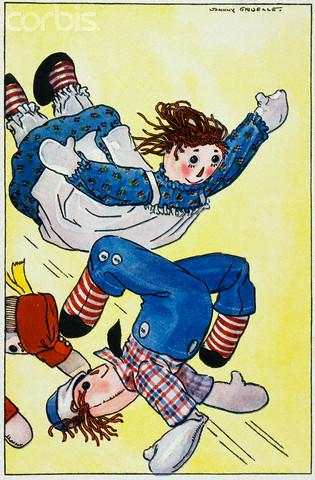As readers are aware, the Consumer Product Safety Commission yesterday advised thrift stores and other resellers and distributors of used goods to discard (unless they wished to test for lead or take other typically unpractical steps such as contacting manufacturers) children’s books printed before 1985 and a very wide range of other children’s products, including apparel and playthings.

According to a commenter at a very busy Etsy thread on the subject, stores are already beginning to act on this advice:
I just came back from my local thrift store with tears in my eyes! I watched as boxes and boxes of children’s books were thrown into the garbage! Today was the deadline and I just can’t believe it! Every book they had on the shelves prior to 1985 was destroyed! I managed to grab a 1967 edition of “The Outsiders” from the top of the box, but so many!
People who deal more systematically in children’s books for a livelihood now face unpleasant choices. From our comments section, Valerie Jacobsen:
We own a small, local used bookstore and have been selling used books on the Internet since 1995.
Last year we shipped over 4500 used books to nearly 50 countries. (Note that CPSIA not only regulates distribution and sale but export as well.)
Our bookstore is the sole means of income for our family, and we currently have over 7000 books catalogued. In our children’s department, 35% of our picture books and 65% of our chapter books were printed before 1985.
Many of our older children’s books have painted decorative titles and other cover embellishment, which decoration is an extremely small quantity and which may or may not contain over 600 ppm lead. (The limits for each accessible part or paint layer are going to 300 ppm in August and 100 ppm in 2011.)
We have read the legislation, called our representative, called our senator, contacted the CPSC (no answer), read all of the CPSC press releases, and contacted a lawyer. We still honestly have no idea what is legal to sell, but we cannot simply discard a wealth of our culture’s nineteenth and twentieth children’s literature over this.
And from the same commenter today, following up after the CPSC’s issuance of guidance to small businesses last night:
I wasn’t thrilled with the exception stating that we can sell pre-1985 children’s books as long as they are pricey vintage collectibles for adult collectors. Um, great, but most of our children’s books, even our older children’s books, are sold for children to read. And read them, they do.
We ran an audit in our bookstore today. We have about 7000 books catalogued. Of our children’s chapter books, about 65% are pre-1985. Of our children’s picture books, about 35% are pre-1985. Most of these sell for under $10 and are stocked as children’s reading.
As an ethical matter, I really can’t discard our cultural heritage just because the CPSC has decreed that books published through *1984* may or may not still form a legal part of the canon of children’s literature for our culture.
I was willing to resist the censorship of 1984 and the Fire Department of Fahrenheit 451 long before I became a bookseller, so I’d love to run a black market in quality children’s books–but at the same time it’s not like the CPSC has never destroyed a small, harmless company before. It’s a scary thing to know that what you are doing is a positive good for the community–and yet possibly, strangely illegal.
Also, I am comforted by no promises from Nord and Moore that are not clear consequences of CPSIA itself. The membership of the commission will probably be changed this year, and if Waxman gets much input into the new membership, we could end up with five first rate cuckoos.
To which commenter Carol Baicker-McKee responds:
Valerie, please, for the sake of children and history hang onto your books! I kept thinking this law would go away, but now I’m worried that an important part of our heritage is genuinely threatened. Many, many children’s books printed before 1985 are now out of print and do not exist still in a form that would make them easy to republish (printing plates are usually destroyed when a book goes out of print and older books did not have electronic versions). Many books, though of enduring value to children and social scientists, may not exist in conditions or simply don’t fall into categories that make them appealing to collectors, the one group besides packrats that I guess is still allowed to own them. Although organizations like the Gutenberg Project have been working to scan and preserve many older children’s books in electronic form, they can only target books that are no longer copyright protected, a very small portion of the children’s books printed since 1985.
If nothing happens to change this law soon, I promise I will spend whatever money and devote whatever space I can to buying up these older books. I’ll be happy to label myself a collector (and I’m subversive enough to leave the books lying around where kids might “accidentally” read them).
A “relabel everything as collectible” strategy is, however, of limited legal help to retailers, because the law provides that they are liable if they sell a product which will commonly be understood as destined for use by children, whether or not they label it as such.
Deputy Headmistress at Common Room, who has been a key CPSIA blogger, deals in second-hand books and has now pulled many of her listings off Amazon; she has a big roundup as well as this. She also points out, citing testing done by Jennifer Taggart, that color illustrations in some old children’s books do flunk the new and stringent rules set by CPSIA for lead content; this does not necessarily mean they pose any hazard to actual children, provided the children use the books for reading and visual enjoyment rather than as something to chew, lick, or devour holes through, Very-Hungry-Caterpillar style. There continues to be an extreme shortage (as in: zero) of cited instances of children in this country being in fact poisoned by the lead in old book illustrations.
Design Loft carefully examines some of the implications for libraries, fiscal and otherwise, of trying to CPSIA-proof pre-1985 holdings. For weeks now librarian and bookseller groups have been sounding the alarm about the law’s coverage of books: Library Journal, Publisher’s Weekly and earlier, and ZRecommends, the American Library Association and more (PDF), Rick Woldenberg. Perhaps this activism helped stimulate the CPSC’s “post-1985 = relatively safe” guidance, but that guidance has only served to underscore the corresponding message of “pre-1985 = not legally safe”.
More: Mark Riffey, Iain Murray, CEI “Open Market”. And the American Library Association, contrary to what was heard earlier, is now taking the position that the law does not apply to libraries unless it hears otherwise. I think at this point if I were them I would take that position too, wouldn’t you?
More: Reactions from Houston criminal defense blogger Mark Bennett at Defending People and again at Blawg Review #199, Carter Wood at NAM ShopFloor and again, David Foster at Chicago Boyz, Der Schweizer Narr (from Switzerland, in German), The Anchoress, Todd Seavey, Open Your Ears and Eyes, Blackadder’s Lair, John Holbo/Crooked Timber, 5 Kids and a Dog, International House of Bacon (CPSIA “the single worst piece of regulation in my lifetime”), Vivian Zabel/Brain Cells and Bubble Wrap, She’s Right, Joey and Aleethea, Dewey’s Treehouse, Sherry/Semicolon Blog, and Classic Housewife.

